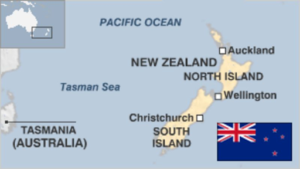In news– Recently, the Maori Party of New Zealand has launched a petition to officially change the country’s name to “Aotearoa”, which means “land of the long white cloud” in the indigenous Te Reo Maori language.
Why such a campaign?
- As per the Maori Party, only 3 percent of the people living in the country currently speak the Te Reo Maori language language.
- Hence the Maori Party has demanded to rename New Zealand as well as restore the Maori names for all towns, cities and place names.
History of the name Aotearoa-
- New Zealand’s tribal population believes the name Aotearoa was first given by Kupe, an East Polynesian explorer who figures in Maori tales somewhere around 1200-1300 AD.
- As per legends, when Kupe, his wife Kuramarotini, and crew were sailing to find out what lay beyond the horizon, they spotted a large landmass shrouded in white cloud in the distance.
- It was then Kuramarotini shouted ‘”He ao! He ao! He Aotea! He Aotearoa (A cloud, a cloud! A white cloud! A long white cloud!)”.
- Earlier Māori names for New Zealand included Nu Tirani, which was used in Te Tiriti o Waitangi, along with Nu Tirene, used in the He Whakaputanga Declaration of Independence.
- Aotearoa was originally used by the Māori people in reference to only the North Island but, since the late 19th century, the word has come to refer to the whole archipelago.
History of the name- New Zealand-
- The history behind the country’s present name goes back to the 1640s when Abel Tasman, a Dutch explorer with the Dutch East India Company (VOC), sighted the South Island.
- The country then subsequently appears on Dutch maps as “Nieuw Zeeland”, named after the Dutch province of Zeeland.
A century later, English navigator Captain James Cook set foot on the Island and in his map he mentioned the country as “New Zealand”.
About New Zealand-
- New Zealand is a wealthy Pacific nation dominated by two cultural groups – New Zealanders of European descent, and the Maori, who are descendants of Polynesian settlers.
- It is bordered by the South Pacific Ocean and the Tasman Sea.
- It gained full independence from Britain in 1947.
- It is made up of two main landmasses—the North Island (Te Ika-a-Māui) and the South Island (Te Waipounamu)—and more than 700 smaller islands.
- Around three-quarters of the population lives on the North Island, which is also home to the capital, Wellington.
- Its most populous city is Auckland.
- While the vast majority of New Zealanders speak English, Maori, New Zealand Sign Language also has official language status in the country.
- Currency: New Zealand dollar.
- The endemic flightless Kiwi is a national icon of New Zealand.
- Agriculture is the economic mainstay, but manufacturing and tourism are important.
- It has a largely temperate climate and as it lies in the Southern Hemisphere, the average temperature decreases as you travel south.
Major tribes:
- The status of Māori as the indigenous people of New Zealand is recognised in New Zealand law by the term tangata whenua.
- Maori races are all subdivided into hapus, or tribal families, bearing often a different appellation to that of the parent tribe.

















